



AT - 2 SWATTER Anti-Tank Guided Missile
The SWATTER is a radio-guided antitank guided missile with a HEAT (High Explosive, Anti Tank) warhead. The SWATTERs with manual command to line of sight (MCLOS) guidance have the disadvantage that the operator must track target and missile simultaneously and manually guide the missile to the target. The slow flight speed makes evasive action an effective countermeasure, especially at long ranges.
The SWATTER was introduced into service in 1960 specifically for use with the BRDM reconnaissance vehicles. The SWATTER is mounted on BRDM/BRDM-2 scout vehicles with four launch rails on a traversable mount. When the launcher is raised for firing, armor plates on the BRDM move to the sides, while the launcher on the BRDM-2 is attached to the underside of a flat, retractable, armored cover. The Mi-8/HIP E can mount four SWATTERs above its outboard weapons racks, and the Mi-24/HIND A and D mount four SWATTERs on wingtip launch rails. BRDM/BRDM-2 SWATTERs are sometimes found in the antitank battery of motorized rifle regiments although this role is more likely filled by the AT-3 or AT-5. The BRDM-mounted SWATTERs with MCLOS guidance were replaced by the new AT-5/SPANDREL.
The Mi-24 helicopter was equipped with the heavy 9M17 Skorpion (AT-2 Swatter) missile of the Falanga [Phalanx] family (Vertoletnaya Falanga-V helicopter version). Its older version, the 9M17M, was guided manually by commands from the pilot tracking its flight. Its 9M17P version is guided semiautomatically by an on-board Raduga-F set, the operator's sole task being to keep the target within field of view of the sight eyepiece. Signals are transmitted to the missile over radio. The appearance of the helicopter-mounted SWATTER C, retrofitted with a semiautomatic IR/radio guidance system and IR terminal homing, was apparently an interim measure pending the full deployment of the longer-range, second-generation missile AT-6/SPIRAL. SWATTERs are currently seeing limited use, however the AT-2c uprated version, are still in wide use as helicopter-mounted missiles.
The SWATTER-A has a maximum range of 2500 meters and a minimum range of 500 meters. It has manual command to line of sight (MCLOS) guidance. This means that the missile operator literally flies the missile onto the target using a small joystick. The missile has a flare in its tail that helps the operator fly the missile down his line of sight to the target. Unlike later ATGM's which use a wire to transmit commands from the operator to the missile, the SWATTER uses radio. The SWATTER B also has MCLOS guidance but the maximum range was extended to 3500 m. The SWATTER C was designed as an interim between the SWATTER B and the AT-6 SPIRAL for use by helicopters. The C version uses semi-automatic command line of sight (SACLOS) guidance instead of MCLOS guidance. The difference is that instead of manually flying the missile with a joystick, the operator simply keeps the cross hairs of his sight on the target and the missile flies itself there. In addition the missile has terminal IR guidance and a maximum range of 4000 m.
The 9M17P SWATTER missile's length is 1160 mm, its body diameter is 132 mm, and its launch weight is 31.5 kg. The SWATTER's HEAT warhead weighs 5.4 kg, and can pierce 500 mm thick steel armor. The SWATTER A can engage targets at ranges between 500 and 2,500 meters. SWATTER B and C have maximum ranges of 3,500 meters and 4,000 meters respectively. All versions have a flight speed of 150-170 meters per second, resulting in a flight time of 17 seconds to 2,500 meters (SWATTER A), 23 seconds to 3,500 meters (SWATTER B) or 26 to 27 seconds to 4,000 meters (SWATTER C). Armor penetration is over 500 mm, and the probability of first-round hit is 67 percent for SWATTER A and B and over 90 percent for the SWATTER C.
Variants
The initial version of the missile was the SWATTER-A, but two upgrades were introduced in the 1970s, designated SWATTER-B and SWATTER-C. The SWATTER A was introduced in the early 1960s, and the SWATTER B was in service before 1973 when it was first displayed in the Red Square parade. All versions are 1,1 60 mm long and 148 mm in diameter. The SWATTER A and B, both with manual command-to-line-of-sight (MCLOS) guidance, differ in weight (27 kg and 29 kg respectively). However, the AT-2c/SWATTER C has semiautomatic command-to-line-of-sight (SACLOS) guidance with IR terminal homing.
Specifications
|
| Weight | 27.0 kg (A)
29.0
kg (B,C) |
| Length | 1.2 meters |
| Range | 500 - 2500 m (A)
500-3500
m (B)
4000 (C) |
| Warhead | High
Explosive Anti-tank |
| Warhead weight | 5.4 kg |
| Armor Penetration | 500+ mm |
| Launching Platforms | BRDM/BRDM-2
Mi-8 Hip
Mi-24 Hind |
|
Using Nations: | Former Soviet Republics, Afghanistan, Bulgaria, Cuba,
Czechoslovakia, Egypt, Hungary, Libya, Poland, Romania, Syria, Vietnam, Yemen.
|
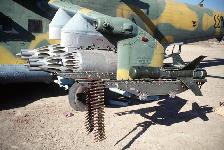

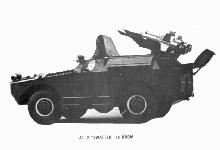
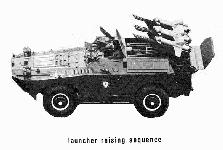
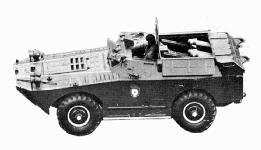
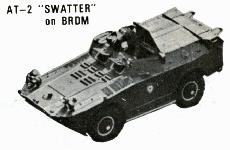
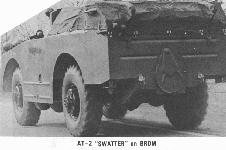
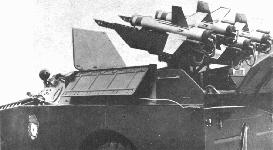
Sources and Methods
- "Survey of Russian Guided Air-to-Ground and Anti-Ship Missiles" by Piotr Butowski,
NOWA TEKHNIKA WOJSKOWA March 1995 No 3, pp 15-19 [JPRS-UMA-95-023: 7 June 1995]
http://www.fas.org/man/dod-101/sys/land/row/at2swatter.htm
Maintained by Robert Sherman
Originally created by John Pike
Updated Friday, January 22, 1999 1:25:08 PM











